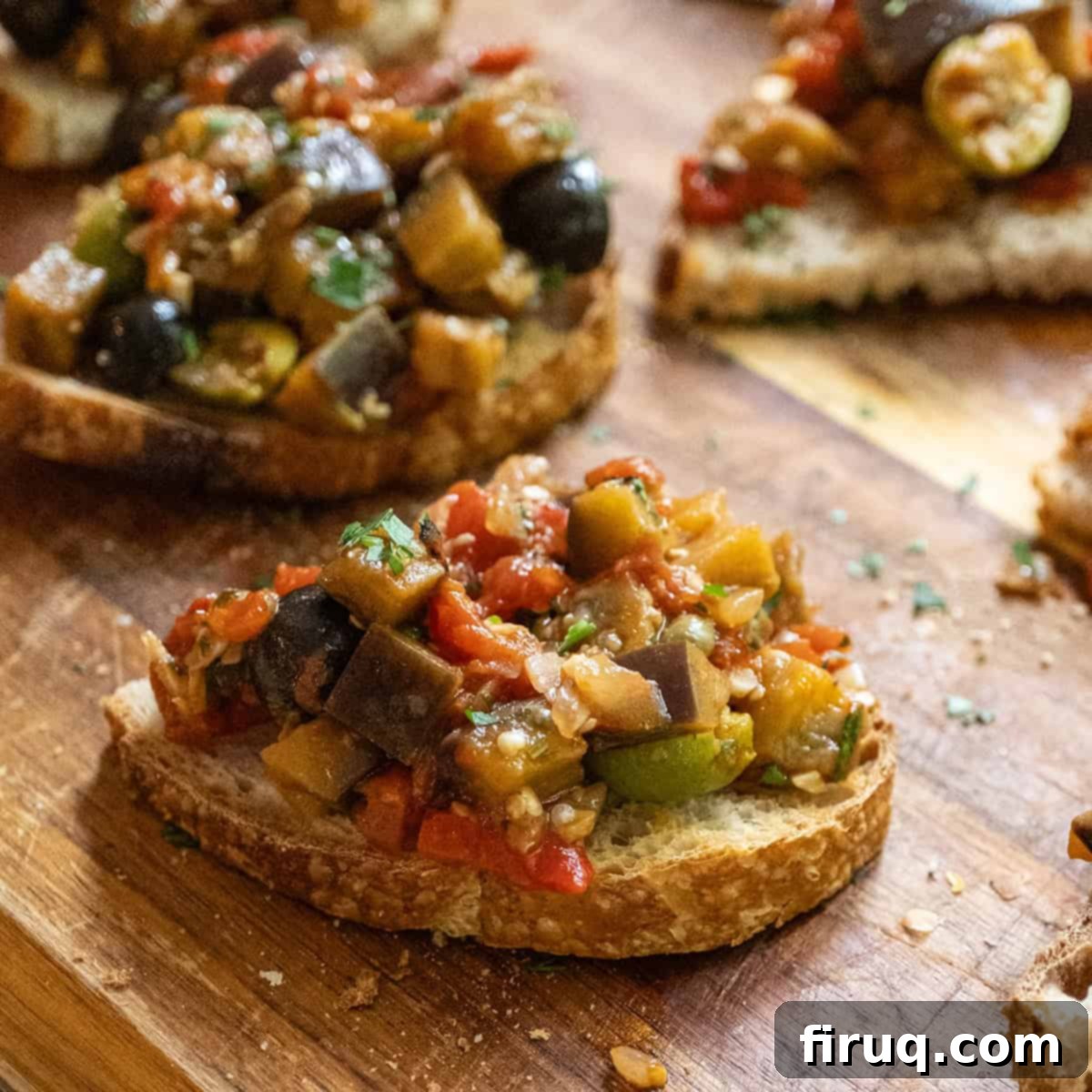Authentic Sicilian Eggplant Caponata Recipe: A Sweet & Sour Italian Delight
Prepare to elevate your appetizer game with the vibrant and incredibly flavorful Eggplant Caponata. This classic Sicilian dish, often served as a topping for crispy toast, delicate crostini, hearty sandwiches, or simple crackers, is a true showstopper. Its irresistible blend of tender eggplant and ripe tomatoes, harmoniously combined with the briny notes of assorted olives and capers, the aromatic punch of garlic and onion, creates a truly unforgettable sweet and sour symphony. Each bite offers an explosion of Mediterranean flavors that will leave your guests reaching for more, making it the most addicting starter at any gathering.
There’s nothing quite like the experience of sharing good company around a table, savoring homemade caponata on perfectly toasted crostini, perhaps alongside some delightful Italian Stuffed Artichokes for a truly authentic Italian spread. Caponata embodies the warmth and generosity of Italian hospitality, promising a delightful culinary journey with every spoonful.

Looking for more delectable toppings for your crostini? Don’t miss our Spiced Apple Chutney, Marinated Eggplant and Onion, or our effortlessly delicious EASY Ricotta Bruschetta. Each offers a unique burst of flavor, perfect for any occasion.
[feast_advanced_jump_to]
What Exactly is Eggplant Caponata?
Eggplant Caponata, sometimes referred to as Caponatini (for smaller eggplant chunks), is a celebrated Italian appetizer that hails from Sicily. At its heart, it’s a vibrant, marinated vegetable relish traditionally made with tender, fried or sautéed eggplant, ripe tomatoes, sweet and tangy onions, pungent garlic, briny capers, and a selection of olives. What truly sets caponata apart is its distinct sweet and sour (agrodolce) flavor profile, achieved by balancing red wine vinegar with a touch of honey or sugar.
This versatile dish is most commonly enjoyed as a flavorful topping for slices of toasted bread or crisp crostini, making it an ideal starter for any meal. However, its uses extend far beyond; it’s a fantastic addition to sandwiches, bringing a Mediterranean twist to your lunch. Imagine swapping out the lox in our Mascarpone Toast with Lox with a generous spoonful of caponata for a surprisingly delicious and unique appetizer.
Caponata is the quintessential “Italian Salsa” – a dish that perfectly captures the lively spirit of communal dining. It’s perfect for serving while everyone gathers around the kitchen table, eagerly anticipating dinner. You’ll find that an empty bowl quickly becomes a testament to its irresistible appeal! Just like Bourbon Candied Pecans, having little snacks like this available before a meal is always a thoughtful touch for your guests.
Our family especially cherished this recipe on Fridays during Lent, offering a delightful meatless option. It often accompanied or even replaced our beloved Peppers and Eggs Sandwich! Its rich flavors and satisfying texture make it a hearty and fulfilling dish, suitable for various dietary preferences and occasions.
Essential Ingredient Notes and Smart Substitutions
Crafting the perfect Eggplant Caponata begins with understanding the role each ingredient plays. Here’s a closer look at what you’ll need and how to make clever substitutions if necessary.
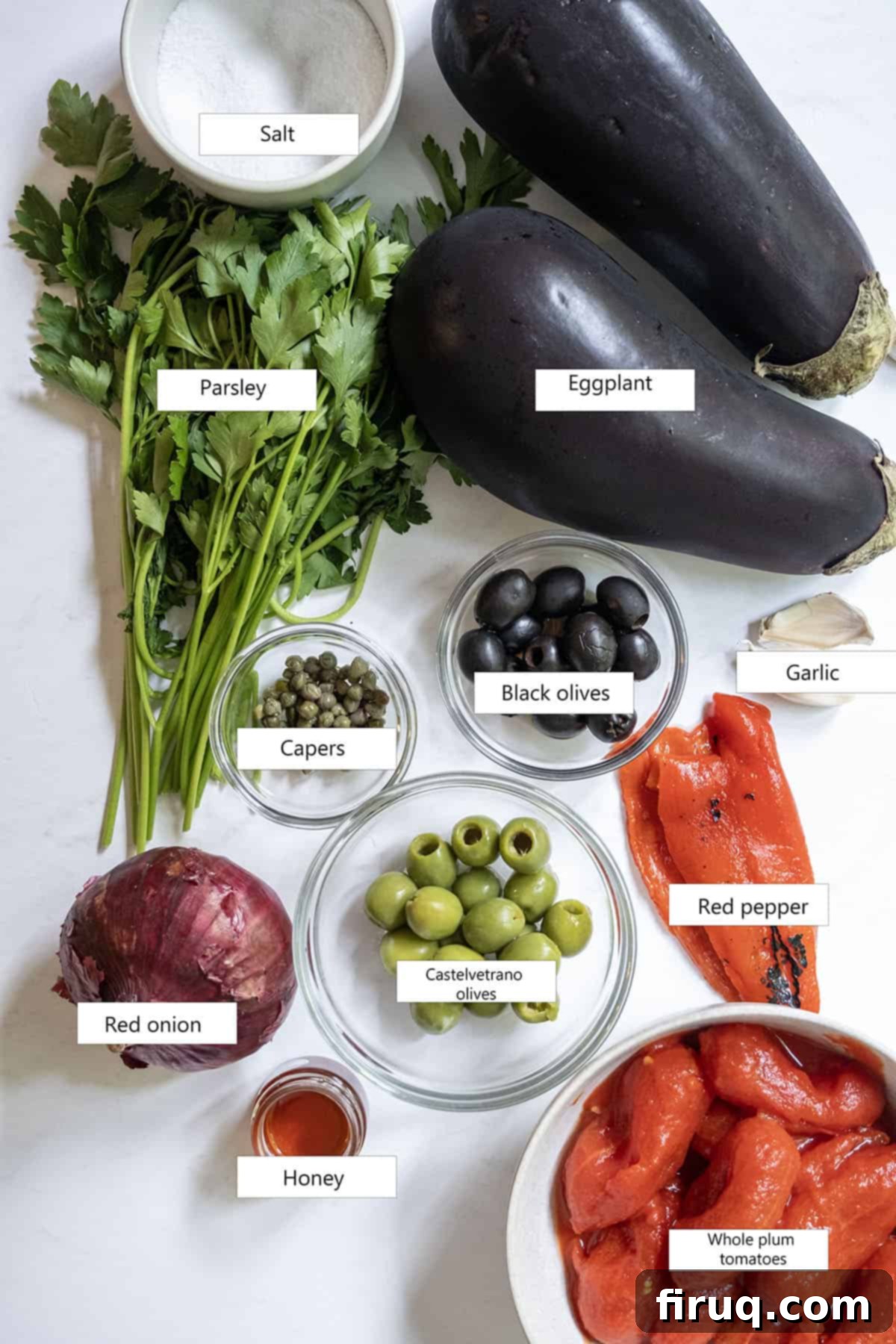
- Whole Plum Tomatoes: For this recipe, I opt for a full can of whole plum tomatoes, but crucially, I drain as much of the liquid as possible. The goal is a chunkier caponata, not a saucy one. You can always save any strained tomato sauce for future recipes by freezing it in a Ziploc bag. For an even richer flavor, consider using San Marzano tomatoes, known for their sweetness and lower acidity.
- Red Onion: The red onion provides a sharp, slightly sweet flavor that mellows beautifully as it cooks. While red onion is preferred for its color and crispness, you can easily substitute yellow or Vidalia onions for a similar, though slightly milder, sweetness.
- Olives: My personal choice for caponata includes a delightful mix of briny Castelvetrano olives and classic black olives, which offer a balanced flavor and appealing color contrast. However, feel free to choose your favorite variety or a mix that appeals to you. Kalamata olives can add a more intense, fruity flavor, while green olives (pitted and chopped) contribute a sharper brine.
- Eggplant: The star of the show! I recommend chopping the eggplant into fairly small, uniform pieces. This size distinction is often what differentiates “caponata” from “caponatini,” which features smaller chunks. A crucial step for perfectly cooked eggplant is to salt the chopped pieces and let them sit for at least 20 minutes. This draws out excess moisture and bitterness, preventing the eggplant from becoming soggy and absorbing too much oil during cooking. After salting, pat them thoroughly dry with a paper towel before proceeding. Italian or globe eggplants work wonderfully, but Japanese or Chinese eggplants can also be used, though they may cook faster due to their thinner skin.
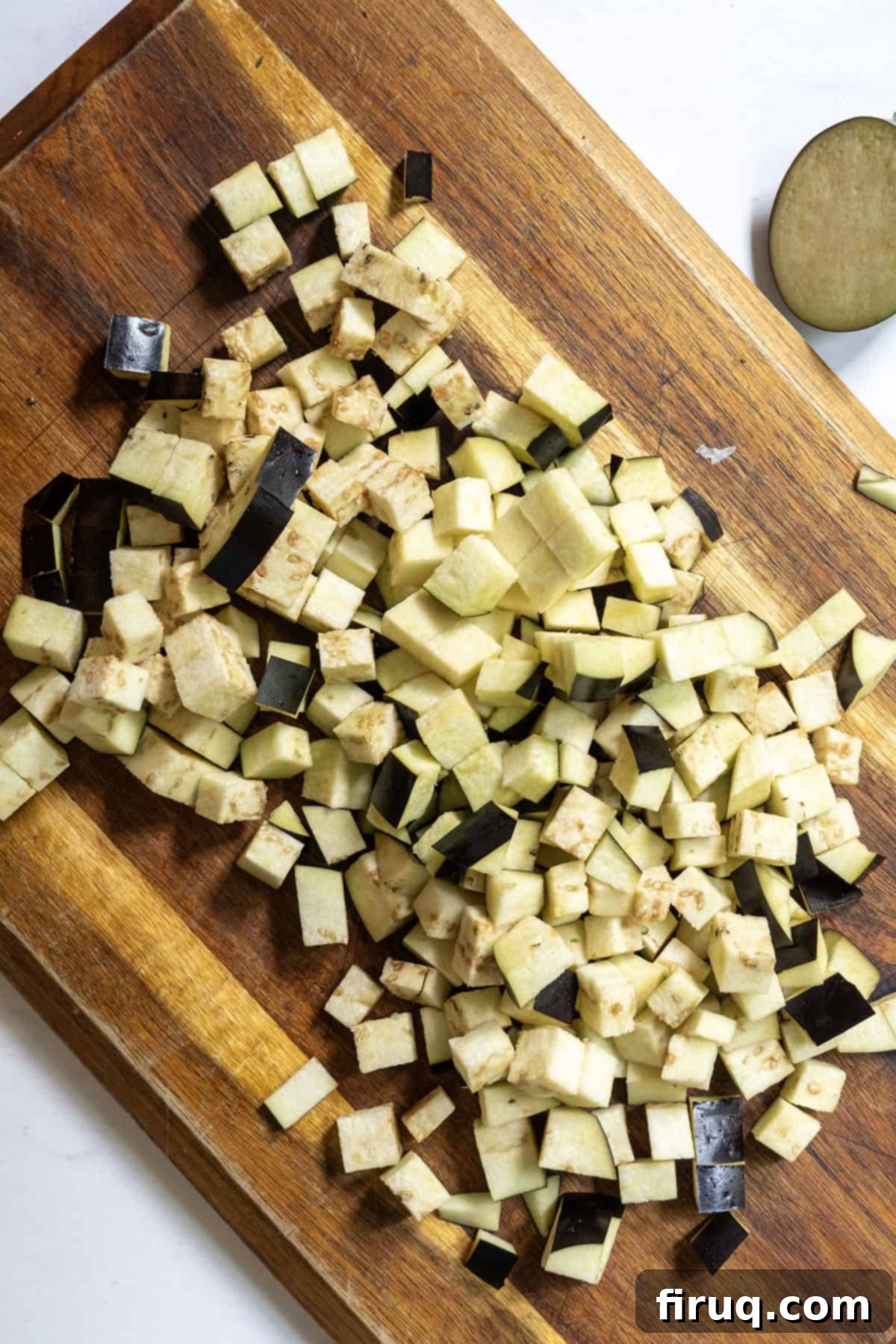
- Capers: These tiny, pickled flower buds add an essential burst of salty, briny flavor that is characteristic of caponata. They contribute significantly to the dish’s overall complexity and depth.
- Garlic: Freshly minced garlic is indispensable for building the aromatic foundation of the caponata, adding warmth and depth.
- Crushed Red Pepper: For a subtle kick that enhances the other flavors without overwhelming them. Adjust the amount to your preference for heat.
- Roasted Red Pepper: Adds a sweet, smoky undertone and a beautiful color contrast, complementing the other vegetables.
- Red Wine Vinegar & Honey: These two ingredients are key to achieving caponata’s signature agrodolce (sweet and sour) balance. The vinegar provides tang, while the honey (or a pinch of sugar) tempers it with sweetness.
- Fresh Chopped Parsley: Stirred in at the end, fresh parsley brightens the dish with its herbaceous notes and adds a pop of color.
*For detailed measurements and further notes, please refer to the comprehensive recipe card below.
Step-by-Step Guide: How to Make Eggplant Caponata
Making Eggplant Caponata is an incredibly easy and rewarding recipe. What’s even better is that it’s meant to be served cold or at room temperature! This fantastic feature means you can prepare it a day or even two ahead of time, making it the perfect stress-free dish for entertaining or busy weeknights. Let the flavors meld and deepen in the refrigerator for an even more exquisite taste.
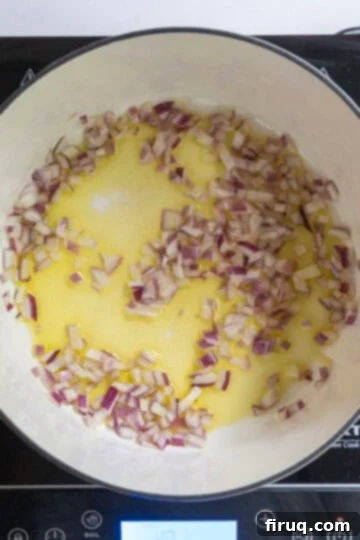
Step 1: Build the Aromatic Base. Heat olive oil in a large saucepan over medium heat. Add the chopped red onion and sauté, stirring occasionally, for 6-8 minutes or until the onion becomes soft and translucent. This gentle cooking allows the onion’s sweetness to develop.
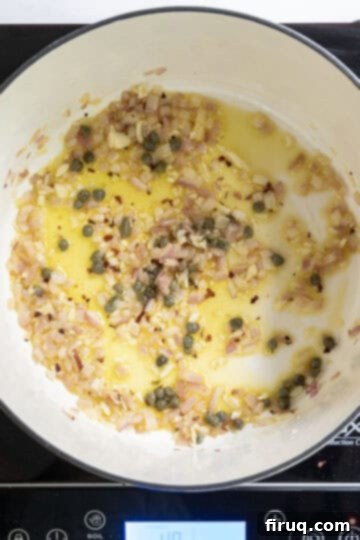
Step 2: Add Garlic and Spice. Incorporate the minced garlic and crushed red pepper into the pan, continuing to sauté for another 2-3 minutes until fragrant. Be careful not to burn the garlic. Next, stir in the capers, allowing their briny essence to infuse the mixture.
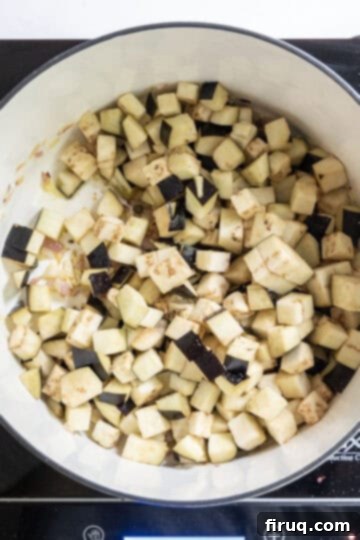
Step 3: Sauté the Eggplant. Add the chopped eggplant (which you’ve already salted and dried) to the pan and season generously with salt. Stir thoroughly to ensure the eggplant is well-coated. Continue to sauté for another 5-8 minutes, stirring frequently, until the eggplant pieces begin to soften and develop a light brown color. This step is crucial for achieving the right texture.
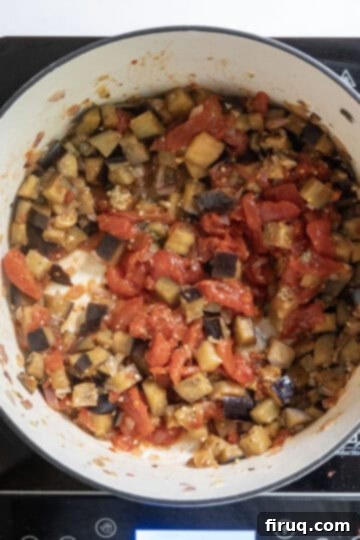
Step 4: Introduce Tomatoes and Vinegar. In a separate bowl, manually crush the drained whole plum tomatoes – this gives a rustic texture. Add the crushed tomatoes to the pan along with the red wine vinegar. Stir everything until all ingredients are thoroughly combined, beginning to form the rich body of the caponata.
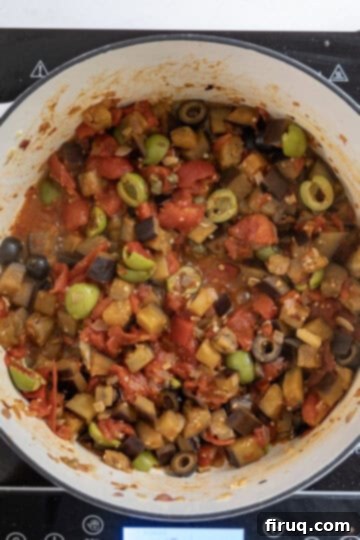
Step 5: Simmer to Perfection. You’ll notice a slight bit of sauce forming at the bottom of the pan. Bring the mixture to a gentle simmer. At this point, add the honey (or sugar for sweetness), the olives, and the roasted red peppers. Continue to simmer the caponata for approximately 20 minutes, stirring frequently to prevent sticking and allow all the flavors to deeply meld and marry together, creating that signature sweet and sour balance.
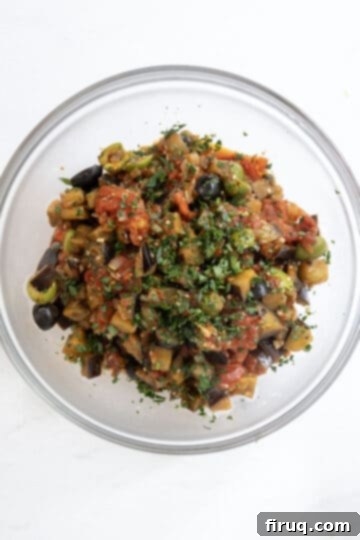
Step 6: Finish and Serve. Once simmered, remove the pan from the heat and carefully transfer the caponata to a serving bowl. Stir in the fresh chopped parsley, which adds a beautiful burst of color and fresh flavor. Cover the bowl and allow the caponata to cool to room temperature, or refrigerate it until thoroughly chilled. Remember, authentic caponata is best served at room temperature or cold!
Serve your exquisite Eggplant Caponata generously over toasted bread or crunchy crostini. It’s truly perfect as an unforgettable side dish or a crowd-pleasing appetizer. For more classic Italian dishes that shine when served over bread, explore our Zucchini alla Scapece and Marinated Eggplant and Onion – both offer delightful flavors and textures!
Pro-Tips for Your Best Eggplant Caponata
Achieve caponata perfection with these expert tips:
- When sautéing the red onion, pay close attention to the heat. If you notice the edges of the onion starting to burn or crisp too quickly, immediately lower the temperature. You want the onions to soften and sweeten, not caramelize or burn, as this forms the delicate base of your caponata.
- Once all the ingredients, especially the tomatoes, have been added to the pan, keep a close eye on the liquid level. If the sauce begins to evaporate completely and the mixture looks dry or starts sticking vigorously to the bottom of the pan, don’t hesitate to add a small amount of water (1-2 tablespoons at a time) to prevent burning and ensure a gentle simmer.
- Remember, this delicious dish is specifically designed to be served as a topping on toast, crostini, or crackers. For the best flavor and texture, it should always be served cold or at room temperature. Making it in advance allows the flavors to meld beautifully, often tasting even better the next day!
- Salting the Eggplant: Don’t skip this critical step! Salting the chopped eggplant before cooking draws out excess moisture and bitterness, resulting in a more tender, less greasy, and intensely flavorful caponata. Pat it thoroughly dry after salting to ensure it browns nicely.
- Adjusting the Sweet & Sour Balance: Caponata’s defining characteristic is its agrodolce (sweet and sour) profile. Taste the caponata after it has simmered. If you prefer it tangier, add a bit more red wine vinegar. For a sweeter profile, stir in a touch more honey or sugar. Adjust to your personal preference.
- Storage: Once cooled, transfer the caponata to an airtight container and store it in the refrigerator. It will keep well for 5-7 days, becoming even more flavorful as it rests.
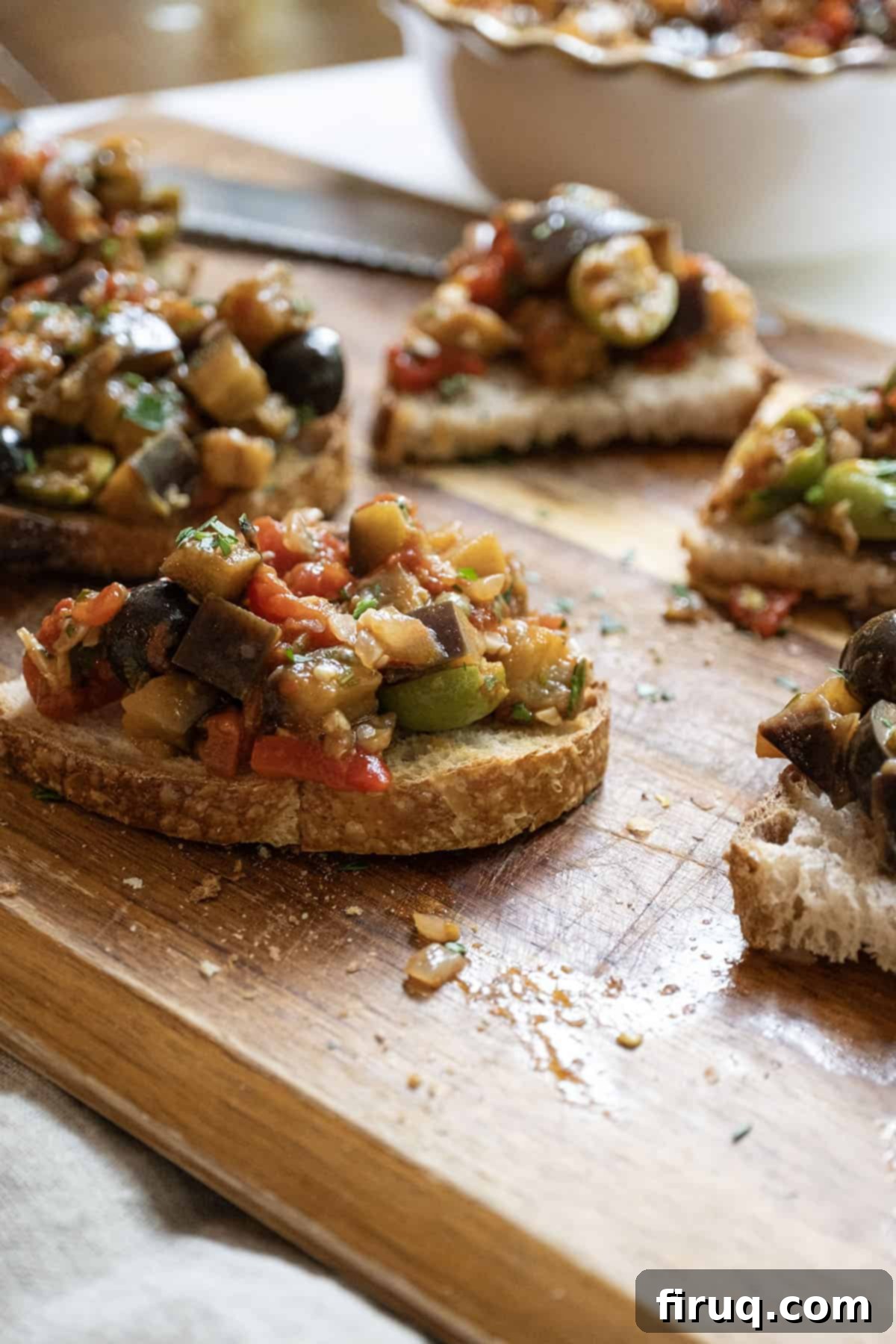
Common Questions About Eggplant Caponata
Eggplant Caponata is incredibly versatile! The most classic way is as a topping for slices of crusty sourdough bread, toasted baguette slices (crostini), or even simple crackers. It’s also fantastic as a spread in sandwiches – try it with an Italian Chicken Cutlet sandwich or our Italian Breakfast Sandwich for a burst of flavor. It also pairs wonderfully with grilled fish or chicken, serves as a vibrant side dish for roasted vegetables, or can be mixed into pasta for a light meal. It’s best enjoyed as a delicious appetizer before dinner or as a light and satisfying lunch.
Caponata is an excellent make-ahead dish! When covered and stored properly in an airtight container, it will last in the refrigerator for 5-7 days. In fact, many argue that caponata tastes even better on the second or third day, as the flavors have more time to meld and deepen. This makes it perfect for party prep or for having a healthy, flavorful topping ready for quick meals throughout the week. It should be served cold or at room temperature, never hot.
Caponata is primarily a marinated eggplant and tomato dish. Its core ingredients typically include sautéed eggplant, ripe tomatoes (often canned whole plum tomatoes), onions, garlic, capers, assorted olives, red wine vinegar for its signature tang, and a touch of sweetness from honey or sugar. Some regional variations might also include celery, pine nuts, or raisins, adding further layers of texture and flavor.
Yes, traditional Eggplant Caponata is naturally vegetarian. It’s packed with vegetables and savory flavors, making it a fantastic plant-based option. To make it strictly vegan, ensure that you use a sweetener other than honey, such as granulated sugar or maple syrup, as honey is not considered vegan by some. Otherwise, all ingredients are typically plant-derived, making it a staple in Mediterranean and vegan diets.
While caponata is best enjoyed fresh or refrigerated, it can be frozen. To freeze, allow it to cool completely, then transfer it to an airtight, freezer-safe container or a heavy-duty freezer bag. It can be frozen for up to 3 months. Thaw overnight in the refrigerator before serving. Note that the texture of the eggplant might become slightly softer after freezing and thawing, but the flavors will still be delicious.
More Irresistible Italian Appetizers & Sides
If you loved this Eggplant Caponata, be sure to explore more of our cherished Italian recipes perfect for sharing:
- Italian Green Bean Salad
- Easy Italian Fried Green Tomatoes
- Baked Italian Stuffed Portobello Mushrooms
- Pepperoni Bread (Stromboli)
Please leave a comment and star rating below in the recipe card! I love to hear what you think of our recipes. Feel free to tag us on Instagram @vindelgiudice.
📖 Recipe

Eggplant Caponata
Vincent DelGiudice
Pin Recipe
Equipment
-
1 large saucepan
-
1 large bowl
Ingredients
- 1 large eggplant or 2 small eggplant, chopped
- 1 28 oz can whole plum tomatoes, drained
- ¼ cup olive oil
- ½ red onion, chopped
- 3 cloves garlic, minced
- 1 teaspoon crushed red pepper
- ½ cup castelvetrano Italian olives
- ½ cup black olives
- 1 tablespoon capers
- 1 roasted red pepper, chopped
- 2 teaspoon salt
- 3 tablespoon red wine vinegar
- 1 teaspoon honey
- 1 tablespoon fresh chopped parsley
Instructions
-
In a large saucepan, heat olive oil over medium heat. Stir in the chopped red onion and sauté for 6-8 minutes until it softens. Add the minced garlic and crushed red pepper, and continue to sauté for another 2-3 minutes until fragrant. Finally, stir in the capers.
-
Add the salted and dried eggplant to the pan and season with additional salt. Stir well to combine. Sauté the eggplant for another 5-8 minutes until it begins to soften and lightly brown. In a separate bowl, crush the drained whole plum tomatoes. Add the crushed tomatoes and red wine vinegar to the pan, stirring until thoroughly combined.
-
Bring the mixture to a gentle simmer. Incorporate the honey, olives, and roasted red peppers. Continue to simmer for 20 minutes, stirring often, allowing the flavors to meld and the caponata to thicken slightly.
-
Remove the pan from the heat and transfer the caponata to a serving bowl. Stir in the fresh chopped parsley. Cover and let it cool to room temperature, or refrigerate until chilled. Serve Caponata at room temperature or cold for the best experience!
Notes
- When sautéing the red onion, adjust the temperature lower if you start to see the edges of the onion burning.
- This dish is meant to be served on toast/crostini as a topping. It should be cold or room temperature for serving.
- Once all the ingredients have been added to the pan, keep a close eye. If the liquid completely evaporates, the dish will start to burn. Be prepared to add a little water (1-2 tablespoons) if needed to maintain a gentle simmer.
Nutrition
